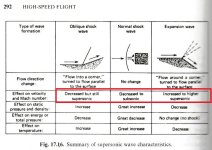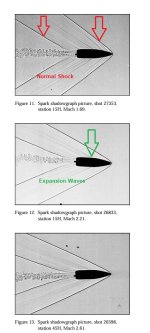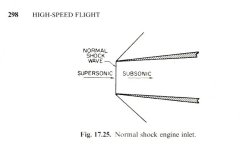davidsog said:
I never said gases cannot travel faster than the speed of sound.
You absolutely claimed several times that the muzzle gases could not travel faster than the speed of sound. You also stated that they were going much slower than the bullet.
I will provide these quotes again.
davidsog said:
Exhaust gases exiting the muzzle cannot travel faster than the speed of sound and they almost instantaneously adhere to that once they exit a confined space.
Note that you absolutely did say they can't travel faster than the speed of sound.
davidsog said:
There is no a 5000fps movement of gas once it escapes the muzzle.
Instead, the motion becomes a vibrational wave which is the basis of normal shock. That vibration is speed limited by the speed of sound.
Note that you did say that the muzzle gas movement was limited to the speed of sound in air. But it clearly is not.
davidsog said:
The gas at exit can only travel at the speed of sound at the local flow level. The bullet is traveling much faster than that.
Note that you claimed the bullet was traveling much faster than the muzzle gases but, in fact, the gases are traveling much faster than the bullet when they exit the muzzle and, as the source I provided proves, they do catch the bullet.
To be very technical in any supersonic flow, there is a tiny portion that does exceed the speed of sound in some cases. It is very localized flow close to the body just before the normal shock depending on the shape of the body in flight. It get roughly mach 1.2 and represents air molecules being shoved out of the way by the shape traveling thru the air mass.
Note that you did state that only a tiny portion of the gases could travel fater than the speed of sound which is not true. The muzzle gases exiting the muzzle are initially traveling several times the speed of sound in air (not "roughly mach 1.2) and stay supersonic for a non-negligible distance.
In fact, you are still making the claim. I have to say, this is pretty remarkable--you are claiming you didn't say something that you clearly did say and at the same time re-iterating the point and arguing in support of it. Quite a novel debate technique.
davidsog said:
There might be a tiny portion of supersonic air exiting the muzzle.
Wrong. The muzzle gases exit at several times the speed of sound in air and stay supersonic for a non-negligible distance.
You understand that the air is not moving around the bullet but rather the bullet is moving thru the air. If it was not for the bullet being there...
You are trying to change the subject. This is about the muzzle gases and very clear and specific claims you have made about their speed on exit and their behavior after exit.
That is how the physics works.
If you believe that physics prevents the muzzle gases from exiting at several times the speed of sound and from traveling at supersonic speeds for a non-negligible distance, then you don't understand the physics because physics does not provide information that is contradictory to real-world observations. That is, in fact, the foundation of science--it must be consistent with real-world observation.
There's no point in continuing until that issue has been resolved.
If you have changed your position and are now agreeing that the muzzle gases can travel faster than the speed of sound in air, much faster, in fact, than the bullet, and can catch and affect the bullet as the source I provided proves, then please clearly say so and stop arguing the point. Also, if you really are motivated by a desire to provide knowledge and understanding, you will certainly want to explain what it was that led you to make such an elementary error and how you misinterpreted the plethora of supporting data you provided to support the incorrect claim.



